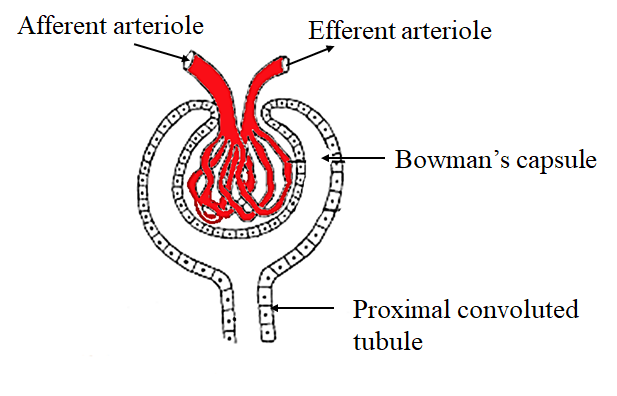
Sketch and label the Malpighian body.
Answer
581.1k+ views
Hint: It is also known as the Renal corpuscle. It allows complete filtration of the blood resulting in the formation of urine.
Complete answer:
1. Bowman’s capsule and glomerulus are together called the Malpighian body. It is part of the structure of nephrons.
2. The glomerulus is a network of capillaries that receives blood from the afferent arteriole and gives it further to the efferent arteriole.
3. The endothelium and basement membrane of the glomerulus and the epithelium of Bowman’s Capsule.
4. The Bowman’s Capsule receives the filtrate from the glomerulus.
5. It is made up of a double layer called the parietal layer and the visceral membrane. The visceral membrane has special cells called the podocytes, that have spaces in between them through which the glomerular filtrate is filtered.
6. The blood comes into the glomerulus through which it is diffused into the Bowman's capsule.
7. Only the smaller solute molecules and water is allowed to pass through the membranes while the blood cells are retained within the glomerulus.
8. Hence, the Malpighian Body allows the filtration of blood so that the waste can be separated from the blood. The filtrate further moves to tubules where fine reabsorption and secretion take place.
Note:
1. Both the kidneys produce approximately 180 liters of filtrate every day.
2. The malpighian body is located in the cortex part of the kidney.
3. Surprisingly, the historic name of the splenic white pulp or the splenic lymphatic nodules is also Malpighian bodies.

Complete answer:
1. Bowman’s capsule and glomerulus are together called the Malpighian body. It is part of the structure of nephrons.
2. The glomerulus is a network of capillaries that receives blood from the afferent arteriole and gives it further to the efferent arteriole.
3. The endothelium and basement membrane of the glomerulus and the epithelium of Bowman’s Capsule.
4. The Bowman’s Capsule receives the filtrate from the glomerulus.
5. It is made up of a double layer called the parietal layer and the visceral membrane. The visceral membrane has special cells called the podocytes, that have spaces in between them through which the glomerular filtrate is filtered.
6. The blood comes into the glomerulus through which it is diffused into the Bowman's capsule.
7. Only the smaller solute molecules and water is allowed to pass through the membranes while the blood cells are retained within the glomerulus.
8. Hence, the Malpighian Body allows the filtration of blood so that the waste can be separated from the blood. The filtrate further moves to tubules where fine reabsorption and secretion take place.
Note:
1. Both the kidneys produce approximately 180 liters of filtrate every day.
2. The malpighian body is located in the cortex part of the kidney.
3. Surprisingly, the historic name of the splenic white pulp or the splenic lymphatic nodules is also Malpighian bodies.

Recently Updated Pages
Master Class 12 Business Studies: Engaging Questions & Answers for Success

Master Class 12 Economics: Engaging Questions & Answers for Success

Master Class 12 English: Engaging Questions & Answers for Success

Master Class 12 Maths: Engaging Questions & Answers for Success

Master Class 12 Social Science: Engaging Questions & Answers for Success

Master Class 12 Chemistry: Engaging Questions & Answers for Success

Trending doubts
What are the major means of transport Explain each class 12 social science CBSE

Which are the Top 10 Largest Countries of the World?

Draw a labelled sketch of the human eye class 12 physics CBSE

How much time does it take to bleed after eating p class 12 biology CBSE

Explain sex determination in humans with line diag class 12 biology CBSE

Differentiate between homogeneous and heterogeneous class 12 chemistry CBSE




